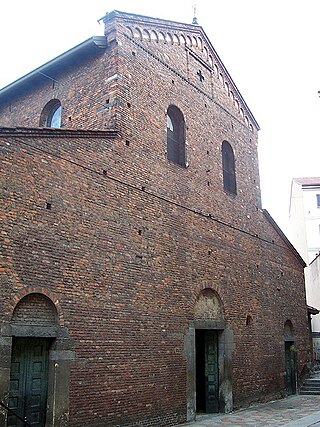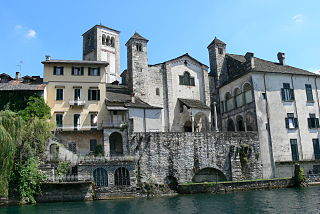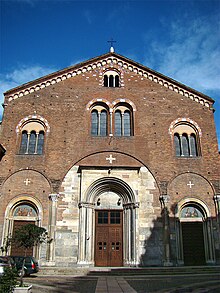History
In the 3rd century, the site of the present church was occupied by a pagan cemetery. Here St. Ambrose commissioned the construction of the Basilica Virginum ("Basilica of the Virgins"), which was finished by his successor Simplicianus, who was buried there. A brick with the mark of the Lombard King Agilulf shows that repairs were made between 590 and 615 AD.
In the ninth century the Cluniac Benedictines took possession of the church. In 1176, a legend associated with the church arose and spread, that held miraculously the bodies of the martyrs held in this church flew as doves to the field of Battle of Legnano, and landed on the city of Milan's Carroccio, (a ceremonial war wagon). This was interpreted by troops as the divine sign promising victory against Frederick Barbarossa's army.
When the building was modified between the 12th and 13th centuries, giving it the present Romanesque appearance, the original walls were preserved to a height of 22 meters. [1] On the night of 6–7 April 1252 the body of Peter of Verona (later St. Peter Martyr) lay in state after his assassination. A great multitude came to watch vigil, and the origins of Peter's cult began, as people started to report miraculous occurrences. In 1517, the convent was placed under the control of the Benedictines of Montecassino.The Benedictines remained here until 1798, when the convent was secularized, and for a time, the monastery was turned into barracks.
In the 16th century the Spanish governor Ferrante Gonzaga had the bell tower lowered by 25 meters. The dome and the side wings were also modified in 1582. Other interventions were carried out in the 19th century, with poor results, while the façade was reworked in 1870. In 1927 stained-glass windows portraying episodes of the battle of Legnano were added.
Architecture and art
On the façade, the arcades that surmount the portals indicate the presence of an ancient portico, now disappeared. The upper part, the most modified in the 19th century, has two mullioned windows in the centre, an upper triple mullioned window and decorative arches. Late Renaissance mullioned windows also decorate the bell tower.
The interior is on the Latin cross plan, with a four-bay nave and two aisles. The transept is divided into two aisles.
The side chapels have decorations from various eras, from Renaissance to Baroque, Rococo and Neoclassical. In the right transept is a painting by Alessandro Varotari (Il Padovanino) portraying the Defeat of the Cammolesi. Next to the apse entrance are saints frescoed by Aurelio Luini. The apse vault is decorated by what is considered Ambrogio da Fossano's masterwork, the Incoronation of Mary .
Also on the left of the apse is the entrance to the small sacellum dedicated to the Martyrs of Anaunia, not before the end of the fourth century, as in a passage in Maximus of Turin's Sermo 81 [2] Maximus designates himself a witness of the martyrdom of three missionary priests in 397 at Anaunia in the Rhaetian Alps.
The western wall of the transept has a Marriage of the Virgin by Camillo Procaccini.

The Papal Basilica of Saint Paul Outside the Walls, commonly known as Saint Paul's Outside the Walls, is one of Rome's four major papal basilicas, along with the basilicas of Saint John in the Lateran, Saint Peter's, and Saint Mary Major, as well as one of the Seven Pilgrim Churches of Rome.

The Basilica of San Petronio is a minor basilica and church of the Archdiocese of Bologna located in Bologna, Emilia Romagna, northern Italy. It dominates Piazza Maggiore. The basilica is dedicated to the patron saint of the city, Saint Petronius, who was the bishop of Bologna in the fifth century. Construction began in 1390 and its main facade has remained unfinished since. The building was transferred from the city to the diocese in 1929; the basilica was finally consecrated in 1954. It has been the seat of the relics of Bologna's patron saint only since 2000; until then they were preserved in the Santo Stefano church of Bologna.

The Basilica of Sant'Ambrogio is an ancient Romanesque-style, Roman Catholic church in the center of Milan, region of Lombardy, Italy.

Santa Maria presso San Satiro is a church in Milan. The Italian Renaissance structure (1476-1482) houses the early medieval shrine to Satyrus, brother of Saint Ambrose. The church is known for its false apse, an early example of trompe-l'œil, attributed to Donato Bramante.

The Basilica of San Michele Maggiore is a Roman Catholic church in Pavia, region of Lombardy, Italy. The building, dating to the 11-12th centuries, is a well-preserved example of the Lombard-Romanesque style.

San Paolo a Ripa d'Arno is a Roman Catholic church in Pisa, region of Tuscany, Italy. It is a pre-eminent example of Tuscan Romanesque church architecture. The church is also locally known as Duomo vecchio.

The basilica of San Nazaro in Brolo or San Nazaro Maggiore is a 4th-century Roman Catholic church in Milan, region of Lombardy, Italy.

The basilica of San Vincenzo in Prato is a Roman Catholic church located in Via Daniele Crespi 6, in Milan, region of Lombardy, Italy. The church maintains most of its original Palaeo-Christian appearance.

San Marco is a church in Milan, northern Italy.

Santa Maria del Carmine is a church in Pavia, Lombardy, northern Italy, considered amongst the best examples of Lombard Gothic architecture. It was begun in 1374 by Gian Galeazzo Visconti, Duke of Milan, on a project attributed to Bernardo da Venezia. The construction followed a slow pace, and was restarted in 1432, being finished in 1461.

Arezzo Cathedral is a Roman Catholic cathedral in the city of Arezzo in Tuscany, Italy. It is located on the site of a pre-existing Palaeo-Christian church and, perhaps, of the ancient city's acropolis.

The Abbey of Santa Maria di Rovegnano is a Cistercian monastic complex in the comune of Milan, Lombardy, northern Italy. The borgo that has developed round the abbey was once an independent commune called Chiaravalle Milanese, now included in Milan and referred to as the Chiaravalle district.

Catania Cathedral, dedicated to Saint Agatha, is a Roman Catholic cathedral in Catania, Sicily, southern Italy. It was the seat of the Bishops of Catania until 1859, when the diocese was elevated to an archdiocese, and since then has been the seat of the Archbishops of Catania.

The Basilica di Sant'Andrea is the church of a monastery in Vercelli, Piedmont, northern Italy, founded in 1219 by Cardinal Guala Bicchieri and completed in 1227. It represents an early example of Gothic architecture in Italy, inspired by Cistercian models and featuring Romanesque elements as well.

Innichen Abbey is a former Benedictine monastery in Innichen, South Tyrol in northern Italy. Founded in the 8th century, its collegiate church dedicated to Saint Candidus, rebuilt in the 12th–13th centuries, is considered the most important Romanesque building in Tyrol and the Eastern Alps. It is home to a 13th-century sculpture and a fresco cycle from the same age in the dome.

The Oratorio di San Protaso is a church in via Lorenteggio, Milan, Lombardy.

Early Christian churches in Milan are the first churches built immediately after the Edict of Milan in February 313, issued by Constantine the Great and Licinius, which granted tolerance and religious liberty to Christianity within the Roman Empire.

Ancona Cathedral is a Roman Catholic cathedral in Ancona, central Italy, dedicated to Saint Cyriacus. It is the seat of the Archbishop of Ancona. The building is an example of mixed Romanesque-Byzantine and Gothic elements, and stands on the site of the former acropolis of the Greek city, the Guasco hill which overlooks Ancona and its gulf.

The Basilica di San Giulio is a Roman Catholic church on the small Isola San Giulio in the center of Lake Orta, province of Novara, north-western Italy. It has the status of a minor basilica. Although the island is part of the Orta San Giulio municipality, the basilica belongs to the San Giacomo parish, including the island and a portion of the west coast of the lake in San Maurizio d'Opaglio municipality.























